More than 24,000 acres of western Canada have been consumed so far this wildfire season.
By Chris Walker
May 14, 2024
Source: Truthout

Smoke from Canadian wildfires has prompted air quality warnings for some states in the upper Midwest of the U.S.
Although wildfires in Canada have not yet reached levels seen during last year’s disastrous wildfire season, they have still wrought a destructive path, resulting in mass evacuations in some areas. It’s widely believed that long-lasting drought conditions caused by the climate crisis, coupled with El Niño/La Niña weather patterns, are to blame for the current conditions and that a catastrophic wildfire season is still possible, with some predicting that it could eventually be worse than the 2023 season.
On Monday, the Minnesota Pollution Control Agency said that fine particle levels created by the Canadian wildfires were predicted to reach “red” category air quality, a rating that is considered “unhealthy for everyone.” The agency encouraged all affected residents — especially those with sensitivities — to avoid prolonged exposure and to refrain from activities that required heavy exertion outdoors.
In addition to Minnesota, residents in the northern two-thirds of Wisconsin were advised that outdoor air would be unhealthy for sensitive people. The upper peninsula of Michigan also saw hazy skies, with some residents saying that they could smell the smoke in the air.
The Associated Press reported that smoke and problematic atmospheric conditions could hit more southern areas of the Midwest by midweek, spreading into Iowa and northern Illinois and even reaching Chicago.
More than 24,000 acres of western Canada have been consumed by wildfires so far. As of May 12, there were 90 wildfires actively ongoing.
Meanwhile, in Canada, thousands of residents have been evacuated due to the spread of the fires, including about 7,200 people near the Northern Rockies Regional Municipality and Fort Nelson First Nation. Government officials in those areas have warned residents that, should they choose to stay despite the evacuation orders, there won’t be enough resources to help them if they need aid, nor will grocery stores or other places be open until the situation calms down.
“This is an extremely difficult time for people that have been impacted. Our thoughts are with you and the province is there to support you,” said Bowinn Ma, the minister of emergency management and climate readiness for British Columbia.
Canada experienced its worst year of wildfires in 2023, when around 45 million acres were burned. Although wildfires may not reach the same levels this year, the conditions at the start of this current wildfire season indicate that it could still be a bad year overall.
Government officials warned in April about the impending season, noting that, with a dryer-than-usual winter in Canada this year — and higher temperatures along with it — the summer months would likely be devastating.
“With the heat and dryness across the country, we can expect that the wildfire season will start sooner and end later, and potentially be more explosive,” said Harjit Sajjan, the minister for emergency preparedness, during a press conference last month.
Those trends likely have to do with the global climate crisis; indeed, 2023 was the hottest year ever recorded. Multiple studies have demonstrated that warmer global conditions make it easier for vegetation to dry out — a key component in fueling more disastrous wildfires in Canada and elsewhere. A study of 2023’s season also concluded that the climate crisis more than doubled the likelihood of wildfires in some parts of the country.

Smoke from Canadian wildfires has prompted air quality warnings for some states in the upper Midwest of the U.S.
Although wildfires in Canada have not yet reached levels seen during last year’s disastrous wildfire season, they have still wrought a destructive path, resulting in mass evacuations in some areas. It’s widely believed that long-lasting drought conditions caused by the climate crisis, coupled with El Niño/La Niña weather patterns, are to blame for the current conditions and that a catastrophic wildfire season is still possible, with some predicting that it could eventually be worse than the 2023 season.
On Monday, the Minnesota Pollution Control Agency said that fine particle levels created by the Canadian wildfires were predicted to reach “red” category air quality, a rating that is considered “unhealthy for everyone.” The agency encouraged all affected residents — especially those with sensitivities — to avoid prolonged exposure and to refrain from activities that required heavy exertion outdoors.
In addition to Minnesota, residents in the northern two-thirds of Wisconsin were advised that outdoor air would be unhealthy for sensitive people. The upper peninsula of Michigan also saw hazy skies, with some residents saying that they could smell the smoke in the air.
The Associated Press reported that smoke and problematic atmospheric conditions could hit more southern areas of the Midwest by midweek, spreading into Iowa and northern Illinois and even reaching Chicago.
More than 24,000 acres of western Canada have been consumed by wildfires so far. As of May 12, there were 90 wildfires actively ongoing.
Meanwhile, in Canada, thousands of residents have been evacuated due to the spread of the fires, including about 7,200 people near the Northern Rockies Regional Municipality and Fort Nelson First Nation. Government officials in those areas have warned residents that, should they choose to stay despite the evacuation orders, there won’t be enough resources to help them if they need aid, nor will grocery stores or other places be open until the situation calms down.
“This is an extremely difficult time for people that have been impacted. Our thoughts are with you and the province is there to support you,” said Bowinn Ma, the minister of emergency management and climate readiness for British Columbia.
Canada experienced its worst year of wildfires in 2023, when around 45 million acres were burned. Although wildfires may not reach the same levels this year, the conditions at the start of this current wildfire season indicate that it could still be a bad year overall.
Government officials warned in April about the impending season, noting that, with a dryer-than-usual winter in Canada this year — and higher temperatures along with it — the summer months would likely be devastating.
“With the heat and dryness across the country, we can expect that the wildfire season will start sooner and end later, and potentially be more explosive,” said Harjit Sajjan, the minister for emergency preparedness, during a press conference last month.
Those trends likely have to do with the global climate crisis; indeed, 2023 was the hottest year ever recorded. Multiple studies have demonstrated that warmer global conditions make it easier for vegetation to dry out — a key component in fueling more disastrous wildfires in Canada and elsewhere. A study of 2023’s season also concluded that the climate crisis more than doubled the likelihood of wildfires in some parts of the country.
Canadian wildfire smoke chokes Minneapolis with worst air quality in America on Monday
Brian Donegan, Andrew Wulfeck
Updated Mon, May 13, 2024
MINNEAPOLIS – Canada's wildfire season has erupted as dozens of blazes burn in the country's western provinces, and smoke from those fires is choking the skies over the Upper Midwest early this week.
The Twin Cities of Minneapolis-St. Paul in Minnesota claimed the worst air quality in America on Monday after winds carried the smoke southeastward into the northern U.S.
Hazy skies were first seen Sunday over parts of northern Minnesota before spreading farther south into the Twin Cities overnight.
The air quality index (AQI) in Minneapolis reached the "unhealthy" category Sunday night and remained there through much of Monday.
THE AIR QUALITY INDEX EXPLAINED: WHAT AIR QUALITY IS BAD?
Many other communities throughout Minnesota, particularly in central and southern portions of the state, are also experiencing unhealthy AQI readings. The unhealthy air has also spread south and eastward into parts of Iowa and Wisconsin.
HOW IS AIR QUALITY MEASURED?
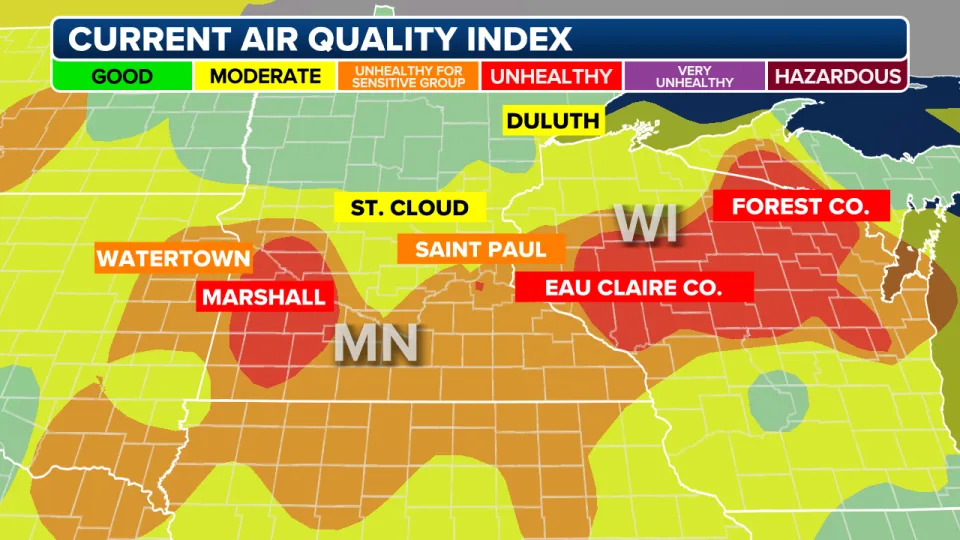
Air quality readings in the Upper Midwest as of 4:50 p.m. CT May 13, 2024.
As a result, air quality alerts have been issued for portions of Minnesota, Iowa and Wisconsin on Monday through midnight.
WHAT IS AN AIR QUALITY ACTION DAY?
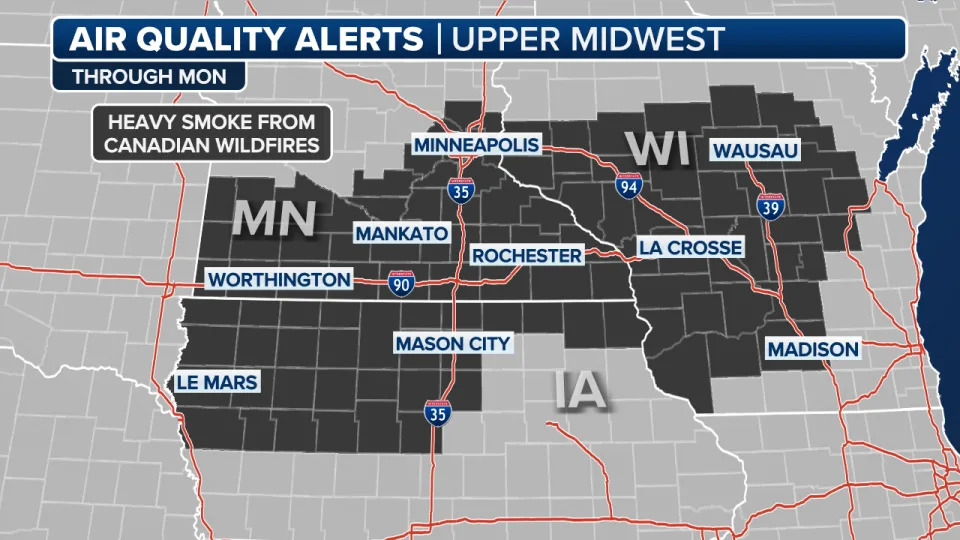
Air quality alerts have been issued in several states as of May 13, 2024.
Computer forecast models show the smoke hugging the Upper Midwest through Monday as it also spreads into the northern Great Lakes.
WHICH U.S. CITIES HAVE THE DIRTIEST AIR? 2024 STATE OF THE AIR REPORT RANKS THEM

The smoke forecast as of May 13, 2024.
The air quality forecast for Minneapolis is improving to "good" for tomorrow through the rest of the work week.
The combination of warm temperatures and an ongoing drought have helped fuel several fires in western Canada, which has prompted thousands to leave their homes.
CANADA HAD NORTH AMERICA'S WORST AIR QUALITY IN 2023 BECAUSE OF WILDFIRES, REPORT SAYS
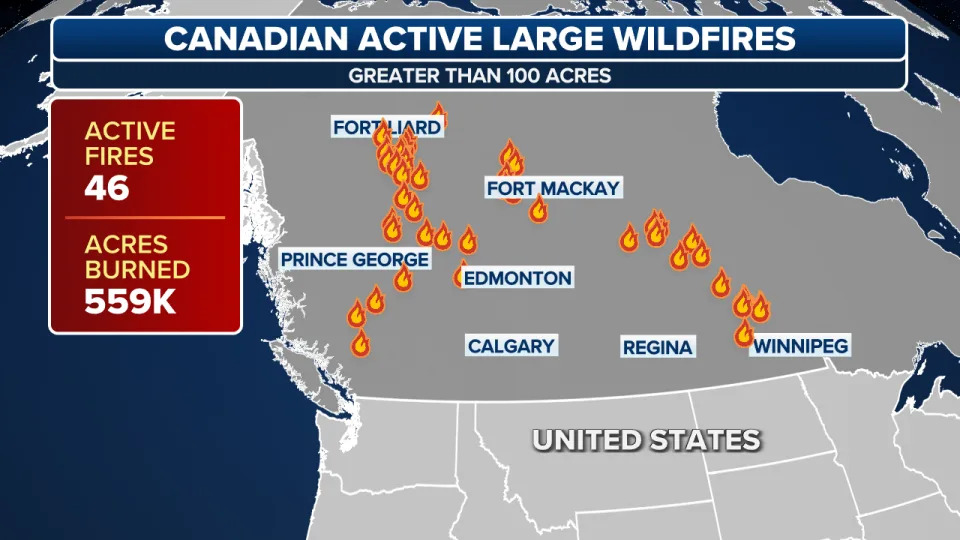
A map of wildfires burning in Canada as of May 13, 2024.
One of the largest fires burning in the province of British Columbia is called the Parker Lake Wildfire. The blaze exploded over the weekend and has now burned more than 13,000 acres as of Monday. The British Columbia Wildfire Service has identified the blaze as "out of control," noting that it continues to spread and could breach the current control line.
Local authorities urged the entire town of Fort Nelson to evacuate and use as few vehicles as possible in an effort to conserve fuel in the region about 400 miles east of Juneau, Alaska.
"Conditions in many parts of B.C., and especially in the Prince George Fire Centre (PGFC), are unseasonably dry and more typical of those observed in the late summer. As a result, fuels are more susceptible to ignition and wildfires can spread more quickly," the British Columbia Wildfire Service said.
Large wildfires are also burning in neighboring Alberta, where thick smoke and poor air quality have been experienced in large parts of the province.
An evacuation alert was issued for Fort McMurray in Alberta as crews respond to what they describe as an "out-of-control wildfire" southwest of town that has burned more than 16,200 acres as of the latest report.
Additionally, authorities are monitoring fires that have rekindled since the historic firestorm of 2023, which burned more than 45 million acres.
The latest North America Drought Monitor showed nearly half of Canada is in drought conditions, with the driest regions being located in the provinces of Alberta and British Columbia.

The drought monitor map for Canada as of May 13, 2024.
An El Niño regime caused extensive snowfall deficits across much of the country, potentially setting up regions for another record-breaking fire season.
"We know from the forecasts that in western and northern Canada, because of a dry winter because of some challenges that are going to be faced, it is likely to be a very bad forest fire season," Prime Minister Justin Trudeau said while visiting British Columbia last week.
In 2023, hundreds of fires in Canada contributed to some U.S. cities seeing their worst air pollution of all time and creating an orange haze in hazardous conditions.
Some Major League Baseball games were postponed, and local health authorities encouraged residents to wear face masks if they ventured outdoors.

Wildfire smoke is back – fires burning across Canada are already triggering US air quality alerts in the Midwest and Plains
Charles O. Stanier, University of Iowa; Gregory Carmichael, University of Iowa, and Peter S. Thorne, University of Iowa
Tue, May 14, 2024
Dozens of wildfires are burning across Canada in May 2024 and sending unhealthy smoke blowing into the northern U.S. again. At the same time, the southeastern U.S. is getting smoke from Mexico, where drought conditions have been fueling fires.
Last year, Canada’s record 2023 wildfire season introduced millions of Americans across the Midwest and northeastern states to the health hazards of wildfire smoke, with air quality alerts that reached levels never seen there before.
Professional baseball games were postponed and the skies in New York City turned orange with haze, at times exposing millions of people to the worst air quality in the world. In some regions, the smoke hung on for days.
The pressing question on many people’s minds: “Is this the new normal?” From our perspective as air quality scientists, we think the answer is likely “yes.”
Global warming means more fires
Hotter, drier conditions, coupled with dry grasses and underbrush that accumulated over decades of fire suppression, have made large wildfires more common.
Canada is experiencing a second consecutive extremely dry year in 2024, and it is also facing the reemergence of fires that smoldered underground through the winter. May 12-14, 2024, smoke from fires in British Columbia and Alberta reached unhealthy levels from Montana to Wisconsin and began to spread south and east into the Midwest and Great Lakes region.
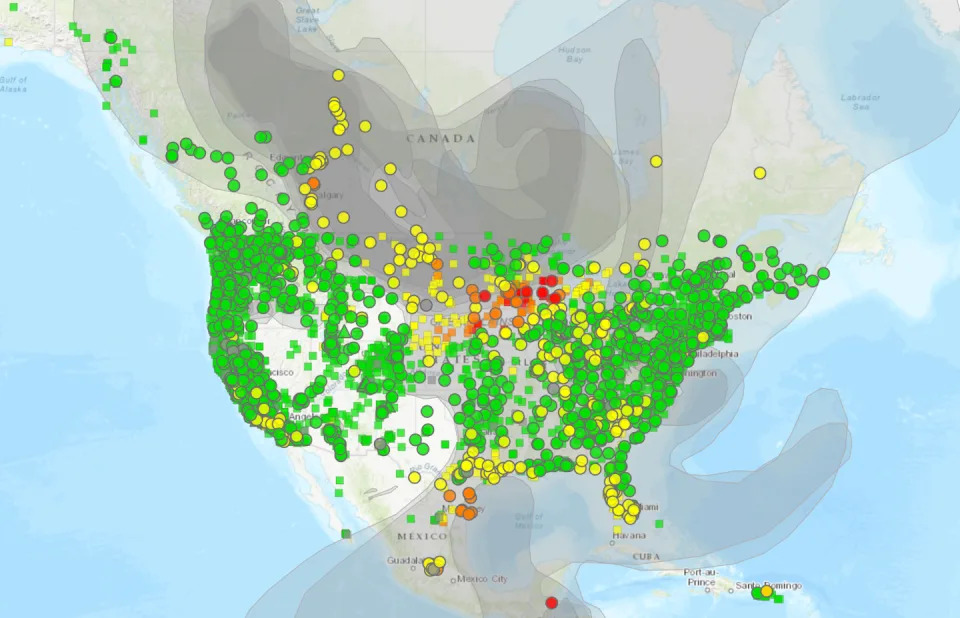
Smoke from wildfires in western Canada led to air quality warnings across parts of the northern U.S. on May 13, 2024. Red dots indicate unhealthy air, orange is unhealthy for sensitive groups, and yellow indicates moderate risk. AirNow.gov
The North American Seasonal Fire Assessment and Outlook for May through July highlights drought conditions in western Canada and Central America and higher than normal fire risk in both regions. It also notes the challenge of forecasting fire risk for later in the year as the El Niño climate pattern transitions to La Niña in late summer.
Computer simulations of the future in a warming climate show there will be more smoky days, higher smoke concentrations, larger burned areas and higher carbon emissions from the fires – which further fuel climate change.
States and the Forest Service can use prescribed fires and forest thinning to help reduce the number and intensity of fire outbreaks, but smoke exposure is still likely to increase as temperatures rise and moisture levels change.
In short, people will need to learn to live with wildfire smoke. It won’t be every year, but it will be more common.
Fortunately, there are several tools and strategies for managing a smokier future.
Preparing for smoky days
Managing the risk of wildfire smoke starts with making smart personal choices.
Think of smoke waves like heat waves: They’re easier to face if you’re prepared and know they’re coming. That means paying attention to forecasts and having face masks, air monitors and clean-air shelters available.
Inhaling the particulate matter and the chemicals in wildfire smoke can exacerbate asthma, worsen existing respiratory and cardiac problems and leave people more susceptible to respiratory infection. People caring for individuals sensitive to smoke, such as young children and older adults, will need to plan for their needs in particular.

Pittsburgh Pirates center fielder Andrew McCutchen wore a face mask to protect against smoke in the air during a Pirates-Padres game on June 29, 2023, in Pittsburgh. Nick Cammett/Diamond Images via Getty Images
To prepare, read up on the risks and warning signs from public health professionals. Living with wildfire smoke may mean using air filtration devices, wearing N95 or KN95 masks on bad air days, modifying outdoor commuting patterns and activity schedules and changing household ventilation choices.
What schools and communities can do
Living with smoke will also require changes to how schools, businesses, apartment buildings and government buildings operate.
Schools can start with setting a threshold for canceling outdoor activities and making sure staff are ready to meet the needs of kids with asthma.
Building managers may need to rethink air filtration and ventilation and deploy air quality sensors. Communities will also need contingency plans for festivals and recreation venues, as well as rules for business to protect outdoor workers.
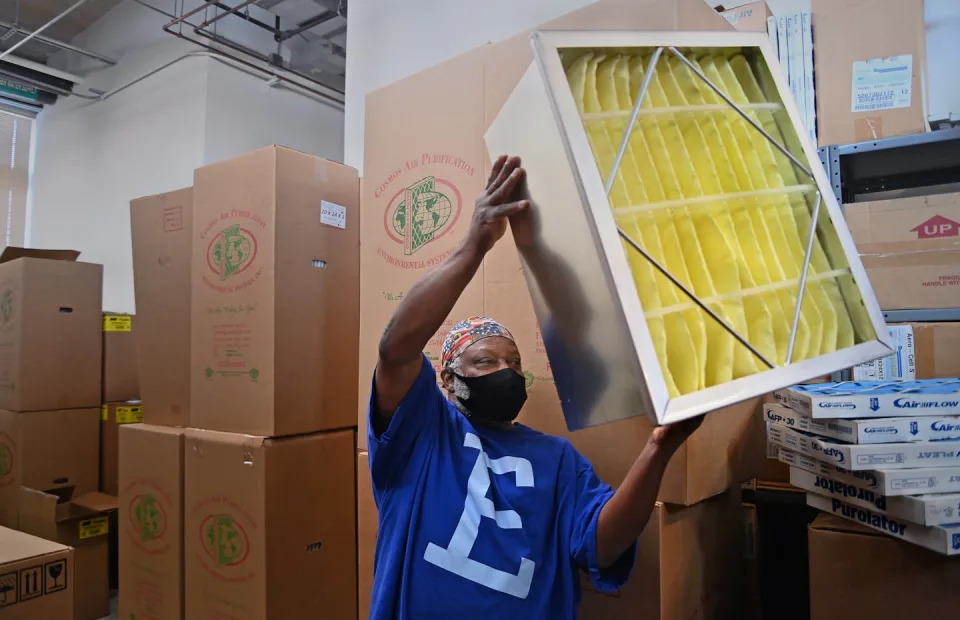
Many schools installed better air filters and classroom air purifiers during spikes in the COVID-19 pandemic. Those measures may be necessary against smoky days in the future. Michael S. Williamson/The Washington Post via Getty Images
Decisions on how to deal with smoke can be complicated. For example, selecting an air purifier can be a daunting task, with over 900 products on the market. The effectiveness of different smoke management interventions are not well known and can vary depending on small implementation details, such as how a mask fits the wearer’s face, whether exterior doors and windows seal tightly and whether filters are installed properly and are replaced often enough.
Improving smoke monitoring and forecasting
The U.S. has an extensive air quality monitoring and forecasting system to help provide some early warning. It uses ground-based air quality monitors, satellite remote sensing systems to detect smoke and fires and computer systems that tie observations together with wind, chemistry and weather. These are supplemented by expert guidance from meteorologists.
However, for average people trying to make decisions about the safety of outdoor activities, the current forecasting system is wanting. This is especially true when smoke blows in from fires far away, or when rapidly changing smoke emission rates and complex wind patterns lead to conflicting forecasts and advisories.

Chicago was under air quality alerts several times during the summer of 2023 as wildfire smoke blew in from Canada. Scott Olson/Getty Images
A few key improvements would go a long way for practical decision making around wildfire smoke. More accurate 10-day forecasts and neighborhood-level forecasts would help communities plan ahead. Merging seasonal weather forecasts of precipitation, humidity and winds with satellite assessments of wildfire fuel conditions could also enhance emergency planning.
Maintaining a strong air quality monitoring network is also important. However, state and local government agencies have reduced the number of ground monitors by about 10% from its peak in 2001. Smoke estimates from satellites and low-cost portable sensors can help, but they work best when they can be cross-calibrated to a well-maintained network of high-accuracy monitors.
We still have a lot to learn
More effective adaptations to smoke will require more research to better understand the effects of repeated exposures to wildfire smoke and the compound hazards that develop when smoke hits simultaneously with other challenges, such as extreme heat.
Community responses, such as providing clean-air shelters – the equivalent to a cooling center during extreme heat – are gaining attention, but there is only limited guidance on what constitutes a clean-air shelter and where and when one would be used.
Living with smoke is emerging as a new reality that people across much of North America will have to contend with again this year, and prepare for in the future.
This is an update to an article originally published Sept. 1, 2023.
This article is republished from The Conversation, a nonprofit, independent news organization bringing you facts and trustworthy analysis to help you make sense of our complex world. It was written by: Charles O. Stanier, University of Iowa; Gregory Carmichael, University of Iowa, and Peter S. Thorne, University of Iowa
Read more:
Wildfire smoke can harm human health, even when the fire is burning hundreds of miles away – a toxicologist explains why
Wildfire smoke and dirty air are also climate change problems: Solutions for a world on fire
Wildfire smoke changes dramatically as it ages, and that matters for downwind air quality – here’s what we learned flying through smoke plumes
Charles O. Stanier receives funding from the National Science Foundation.
Gregory Carmichael receives funding from the National Aeronautics and Space Administration.
Peter S. Thorne receives funding from the U.S. National Institutes of Health and the Burroughs Wellcome Fund.
Brian Donegan, Andrew Wulfeck
Updated Mon, May 13, 2024
MINNEAPOLIS – Canada's wildfire season has erupted as dozens of blazes burn in the country's western provinces, and smoke from those fires is choking the skies over the Upper Midwest early this week.
The Twin Cities of Minneapolis-St. Paul in Minnesota claimed the worst air quality in America on Monday after winds carried the smoke southeastward into the northern U.S.
Hazy skies were first seen Sunday over parts of northern Minnesota before spreading farther south into the Twin Cities overnight.
The air quality index (AQI) in Minneapolis reached the "unhealthy" category Sunday night and remained there through much of Monday.
THE AIR QUALITY INDEX EXPLAINED: WHAT AIR QUALITY IS BAD?
Many other communities throughout Minnesota, particularly in central and southern portions of the state, are also experiencing unhealthy AQI readings. The unhealthy air has also spread south and eastward into parts of Iowa and Wisconsin.
HOW IS AIR QUALITY MEASURED?

Air quality readings in the Upper Midwest as of 4:50 p.m. CT May 13, 2024.
As a result, air quality alerts have been issued for portions of Minnesota, Iowa and Wisconsin on Monday through midnight.
WHAT IS AN AIR QUALITY ACTION DAY?

Air quality alerts have been issued in several states as of May 13, 2024.
Computer forecast models show the smoke hugging the Upper Midwest through Monday as it also spreads into the northern Great Lakes.
WHICH U.S. CITIES HAVE THE DIRTIEST AIR? 2024 STATE OF THE AIR REPORT RANKS THEM

The smoke forecast as of May 13, 2024.
The air quality forecast for Minneapolis is improving to "good" for tomorrow through the rest of the work week.
The combination of warm temperatures and an ongoing drought have helped fuel several fires in western Canada, which has prompted thousands to leave their homes.
CANADA HAD NORTH AMERICA'S WORST AIR QUALITY IN 2023 BECAUSE OF WILDFIRES, REPORT SAYS

A map of wildfires burning in Canada as of May 13, 2024.
One of the largest fires burning in the province of British Columbia is called the Parker Lake Wildfire. The blaze exploded over the weekend and has now burned more than 13,000 acres as of Monday. The British Columbia Wildfire Service has identified the blaze as "out of control," noting that it continues to spread and could breach the current control line.
Local authorities urged the entire town of Fort Nelson to evacuate and use as few vehicles as possible in an effort to conserve fuel in the region about 400 miles east of Juneau, Alaska.
"Conditions in many parts of B.C., and especially in the Prince George Fire Centre (PGFC), are unseasonably dry and more typical of those observed in the late summer. As a result, fuels are more susceptible to ignition and wildfires can spread more quickly," the British Columbia Wildfire Service said.
Large wildfires are also burning in neighboring Alberta, where thick smoke and poor air quality have been experienced in large parts of the province.
An evacuation alert was issued for Fort McMurray in Alberta as crews respond to what they describe as an "out-of-control wildfire" southwest of town that has burned more than 16,200 acres as of the latest report.
Additionally, authorities are monitoring fires that have rekindled since the historic firestorm of 2023, which burned more than 45 million acres.
The latest North America Drought Monitor showed nearly half of Canada is in drought conditions, with the driest regions being located in the provinces of Alberta and British Columbia.

The drought monitor map for Canada as of May 13, 2024.
An El Niño regime caused extensive snowfall deficits across much of the country, potentially setting up regions for another record-breaking fire season.
"We know from the forecasts that in western and northern Canada, because of a dry winter because of some challenges that are going to be faced, it is likely to be a very bad forest fire season," Prime Minister Justin Trudeau said while visiting British Columbia last week.
In 2023, hundreds of fires in Canada contributed to some U.S. cities seeing their worst air pollution of all time and creating an orange haze in hazardous conditions.
Some Major League Baseball games were postponed, and local health authorities encouraged residents to wear face masks if they ventured outdoors.
Wildfire smoke is back – fires burning across Canada are already triggering US air quality alerts in the Midwest and Plains
Charles O. Stanier, University of Iowa; Gregory Carmichael, University of Iowa, and Peter S. Thorne, University of Iowa
Tue, May 14, 2024
Dozens of wildfires are burning across Canada in May 2024 and sending unhealthy smoke blowing into the northern U.S. again. At the same time, the southeastern U.S. is getting smoke from Mexico, where drought conditions have been fueling fires.
Last year, Canada’s record 2023 wildfire season introduced millions of Americans across the Midwest and northeastern states to the health hazards of wildfire smoke, with air quality alerts that reached levels never seen there before.
Professional baseball games were postponed and the skies in New York City turned orange with haze, at times exposing millions of people to the worst air quality in the world. In some regions, the smoke hung on for days.
The pressing question on many people’s minds: “Is this the new normal?” From our perspective as air quality scientists, we think the answer is likely “yes.”
Global warming means more fires
Hotter, drier conditions, coupled with dry grasses and underbrush that accumulated over decades of fire suppression, have made large wildfires more common.
Canada is experiencing a second consecutive extremely dry year in 2024, and it is also facing the reemergence of fires that smoldered underground through the winter. May 12-14, 2024, smoke from fires in British Columbia and Alberta reached unhealthy levels from Montana to Wisconsin and began to spread south and east into the Midwest and Great Lakes region.

Smoke from wildfires in western Canada led to air quality warnings across parts of the northern U.S. on May 13, 2024. Red dots indicate unhealthy air, orange is unhealthy for sensitive groups, and yellow indicates moderate risk. AirNow.gov
The North American Seasonal Fire Assessment and Outlook for May through July highlights drought conditions in western Canada and Central America and higher than normal fire risk in both regions. It also notes the challenge of forecasting fire risk for later in the year as the El Niño climate pattern transitions to La Niña in late summer.
Computer simulations of the future in a warming climate show there will be more smoky days, higher smoke concentrations, larger burned areas and higher carbon emissions from the fires – which further fuel climate change.
States and the Forest Service can use prescribed fires and forest thinning to help reduce the number and intensity of fire outbreaks, but smoke exposure is still likely to increase as temperatures rise and moisture levels change.
In short, people will need to learn to live with wildfire smoke. It won’t be every year, but it will be more common.
Fortunately, there are several tools and strategies for managing a smokier future.
Preparing for smoky days
Managing the risk of wildfire smoke starts with making smart personal choices.
Think of smoke waves like heat waves: They’re easier to face if you’re prepared and know they’re coming. That means paying attention to forecasts and having face masks, air monitors and clean-air shelters available.
Inhaling the particulate matter and the chemicals in wildfire smoke can exacerbate asthma, worsen existing respiratory and cardiac problems and leave people more susceptible to respiratory infection. People caring for individuals sensitive to smoke, such as young children and older adults, will need to plan for their needs in particular.

Pittsburgh Pirates center fielder Andrew McCutchen wore a face mask to protect against smoke in the air during a Pirates-Padres game on June 29, 2023, in Pittsburgh. Nick Cammett/Diamond Images via Getty Images
To prepare, read up on the risks and warning signs from public health professionals. Living with wildfire smoke may mean using air filtration devices, wearing N95 or KN95 masks on bad air days, modifying outdoor commuting patterns and activity schedules and changing household ventilation choices.
What schools and communities can do
Living with smoke will also require changes to how schools, businesses, apartment buildings and government buildings operate.
Schools can start with setting a threshold for canceling outdoor activities and making sure staff are ready to meet the needs of kids with asthma.
Building managers may need to rethink air filtration and ventilation and deploy air quality sensors. Communities will also need contingency plans for festivals and recreation venues, as well as rules for business to protect outdoor workers.

Many schools installed better air filters and classroom air purifiers during spikes in the COVID-19 pandemic. Those measures may be necessary against smoky days in the future. Michael S. Williamson/The Washington Post via Getty Images
Decisions on how to deal with smoke can be complicated. For example, selecting an air purifier can be a daunting task, with over 900 products on the market. The effectiveness of different smoke management interventions are not well known and can vary depending on small implementation details, such as how a mask fits the wearer’s face, whether exterior doors and windows seal tightly and whether filters are installed properly and are replaced often enough.
Improving smoke monitoring and forecasting
The U.S. has an extensive air quality monitoring and forecasting system to help provide some early warning. It uses ground-based air quality monitors, satellite remote sensing systems to detect smoke and fires and computer systems that tie observations together with wind, chemistry and weather. These are supplemented by expert guidance from meteorologists.
However, for average people trying to make decisions about the safety of outdoor activities, the current forecasting system is wanting. This is especially true when smoke blows in from fires far away, or when rapidly changing smoke emission rates and complex wind patterns lead to conflicting forecasts and advisories.

Chicago was under air quality alerts several times during the summer of 2023 as wildfire smoke blew in from Canada. Scott Olson/Getty Images
A few key improvements would go a long way for practical decision making around wildfire smoke. More accurate 10-day forecasts and neighborhood-level forecasts would help communities plan ahead. Merging seasonal weather forecasts of precipitation, humidity and winds with satellite assessments of wildfire fuel conditions could also enhance emergency planning.
Maintaining a strong air quality monitoring network is also important. However, state and local government agencies have reduced the number of ground monitors by about 10% from its peak in 2001. Smoke estimates from satellites and low-cost portable sensors can help, but they work best when they can be cross-calibrated to a well-maintained network of high-accuracy monitors.
We still have a lot to learn
More effective adaptations to smoke will require more research to better understand the effects of repeated exposures to wildfire smoke and the compound hazards that develop when smoke hits simultaneously with other challenges, such as extreme heat.
Community responses, such as providing clean-air shelters – the equivalent to a cooling center during extreme heat – are gaining attention, but there is only limited guidance on what constitutes a clean-air shelter and where and when one would be used.
Living with smoke is emerging as a new reality that people across much of North America will have to contend with again this year, and prepare for in the future.
This is an update to an article originally published Sept. 1, 2023.
This article is republished from The Conversation, a nonprofit, independent news organization bringing you facts and trustworthy analysis to help you make sense of our complex world. It was written by: Charles O. Stanier, University of Iowa; Gregory Carmichael, University of Iowa, and Peter S. Thorne, University of Iowa
Read more:
Wildfire smoke can harm human health, even when the fire is burning hundreds of miles away – a toxicologist explains why
Wildfire smoke and dirty air are also climate change problems: Solutions for a world on fire
Wildfire smoke changes dramatically as it ages, and that matters for downwind air quality – here’s what we learned flying through smoke plumes
Charles O. Stanier receives funding from the National Science Foundation.
Gregory Carmichael receives funding from the National Aeronautics and Space Administration.
Peter S. Thorne receives funding from the U.S. National Institutes of Health and the Burroughs Wellcome Fund.
No comments:
Post a Comment